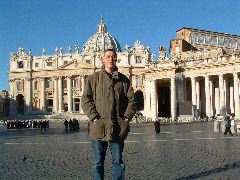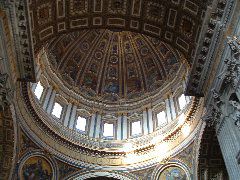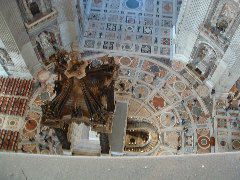from the shrine of St Peter
 If this is Thursday, this must be the Vatican! Today we visited the Vatican Museum, the Sistine Chapel, and the Basilica of St Peter. Jonathan Boardman, chaplain of All Saints, the Anglican church in Rome, gave us a tour of some of the principal works in the museum, and talked about the paintings in the Sistine Chapel. Although I have been in the Chapel twice before, this was the first time since the major restoration of the Michelangelo frescoes. It was also the first time I had really considered the overall scheme of the decoration: the ceiling depicting scenes from the Creation to the Flood; the pairs of pictures on the side walls by a number of earlier artists (Old and New Testament scenes in pairs, where the OT scene is in some way a ‘type’ for the NT one opposite it); and, of course, the Last Judgement on the ‘east’ wall. Here we see Peter and Paul as the strong men of Christ, sporting their perfect, resurrected, bodies (or at least, as Jonathan later noted, perfect in the eyes of Michelangelo; we might not all envisage our perfected bodies as those of East German athletes!).
If this is Thursday, this must be the Vatican! Today we visited the Vatican Museum, the Sistine Chapel, and the Basilica of St Peter. Jonathan Boardman, chaplain of All Saints, the Anglican church in Rome, gave us a tour of some of the principal works in the museum, and talked about the paintings in the Sistine Chapel. Although I have been in the Chapel twice before, this was the first time since the major restoration of the Michelangelo frescoes. It was also the first time I had really considered the overall scheme of the decoration: the ceiling depicting scenes from the Creation to the Flood; the pairs of pictures on the side walls by a number of earlier artists (Old and New Testament scenes in pairs, where the OT scene is in some way a ‘type’ for the NT one opposite it); and, of course, the Last Judgement on the ‘east’ wall. Here we see Peter and Paul as the strong men of Christ, sporting their perfect, resurrected, bodies (or at least, as Jonathan later noted, perfect in the eyes of Michelangelo; we might not all envisage our perfected bodies as those of East German athletes!).
And then to the Basilica of St Peter. The vastness of this building never ceases to amaze. I remember visiting as a schoolboy in 1973. Our guide asked a fellow pupil to walk over to one of the columns and touch the carving of a dove that seemed a few feet off the floor. As he got nearer we realized that far from having to reach down to it, he could not in fact reach it by stretching up. The perfect scale of the building had confused our senses. On the other hand, you do have to wonder what the fisherman from the Sea of Galilee might have made of all this splendour and pomp.
 This is a place where the claims of the bishops of Rome are most evident, from the ‘Tu es Petrus’ mosaic in massive letters written around the base of the dome, to the monuments recalling papal declarations such as the ‘immaculate conception’, and above all the grandiose memorials to a swathe of popes in the main basilica. These explicitly proclaim the primacy and universal immediate jurisdiction of the see of Rome. As an Anglican, I find it very easy to challenge the show of pride and opulance, and the claims to power that these buildings and memorials present (whilst not forgetting that my own church has its own grand buildings, monuments and claims).
This is a place where the claims of the bishops of Rome are most evident, from the ‘Tu es Petrus’ mosaic in massive letters written around the base of the dome, to the monuments recalling papal declarations such as the ‘immaculate conception’, and above all the grandiose memorials to a swathe of popes in the main basilica. These explicitly proclaim the primacy and universal immediate jurisdiction of the see of Rome. As an Anglican, I find it very easy to challenge the show of pride and opulance, and the claims to power that these buildings and memorials present (whilst not forgetting that my own church has its own grand buildings, monuments and claims).
As a contrast to all the show it is a welcome change to descend to the crypt. Here you stand more or less at the level of the basilica built in the time of Constantine in the first half of the fourth century. Immediately beneath the dome and the high altar (with its great baldachino designed by Bernini, and forged from bronze taken from the Pantheon of ancient Rome) stands the tomb of St Peter. Not his actual tomb, I think, which lies another level down, not accessible to the general public, but a shrine to the saint, nonetheless. This is the place to stand and give thanks for the life of Simon son of Jonah, to whom Christ gave the nickname ‘Cephas’ or ‘rock’ (‘petros’ in Greek), and to pray — especially at this time, in the middle of the Week of Prayer for Christian Unity — for the unity of the Church, union amongst Anglicans and union with our other separated brothers and sisters, and especially in this place, union with the see of Rome, with the successors of St Peter.
 When you stand before, or over, the tomb of the leader of the Apostles, you are taken back to New Testament times, to the days 2000 years ago when Jesus walked beside the Sea of Galilee and called Simon, son of Jonah, to follow him, to the days when Simon Peter acclaimed Jesus as the Messiah, the Christ, disowned him, and was forgiven, to the days when he preached the resurrection of Christ in Jerusalem, and then through the eastern Roman Empire, before ending up in Rome, to suffer and die as a witness to the kingdom of God proclaimed by the Jesus he had known. Here, in the crypt of the basilica, the pomp of the main church is forgotten — the roof is low, the walls are plain. Here are the simple tombs of many of the popes, placed close to where they believed Peter was buried. Here it is possible to forget the grandeur that is just a few feet over your head, and to recover a simple spirituality, and the simple message at the heart of what Christians believe, and to which Christians down the ages have borne witness.
When you stand before, or over, the tomb of the leader of the Apostles, you are taken back to New Testament times, to the days 2000 years ago when Jesus walked beside the Sea of Galilee and called Simon, son of Jonah, to follow him, to the days when Simon Peter acclaimed Jesus as the Messiah, the Christ, disowned him, and was forgiven, to the days when he preached the resurrection of Christ in Jerusalem, and then through the eastern Roman Empire, before ending up in Rome, to suffer and die as a witness to the kingdom of God proclaimed by the Jesus he had known. Here, in the crypt of the basilica, the pomp of the main church is forgotten — the roof is low, the walls are plain. Here are the simple tombs of many of the popes, placed close to where they believed Peter was buried. Here it is possible to forget the grandeur that is just a few feet over your head, and to recover a simple spirituality, and the simple message at the heart of what Christians believe, and to which Christians down the ages have borne witness.
It is easy to say that the claims of Rome are misconceived and misunderstood, but even so I find myself not unwilling to allow a primacy of honour to this ancient see, effectively the only one remaining of the ancient patriarchates of Jerusalem (the see of James, the brother of Jesus), of Alexandria, and of Antioch, all three long since having lost their Christian hinterland. This primacy would not be the primacy of the main basilica, a primacy of marble and costly show, a primacy of universal jurisdiction or of infallible pronouncements; rather it would be like the crypt, plain and simple, unadorned, the servant of all, exhibiting moral strength, uncorrupted personal character, and the love of God the Father and of the created world, preached by the carpenter of Nazareth.